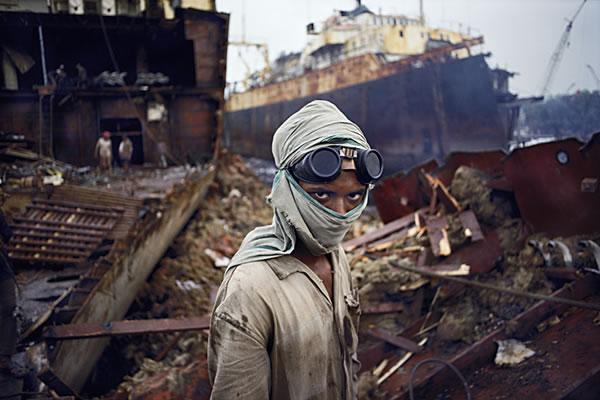Dismantling Ships and the Trajectory of Steel

© 2014 Alain Herzog
Summer series, student work (8): Tell me how you dismantle a ship, and I'll tell how a region can prosper from its steel! This could be the motto of this master’s cycle at ENAC during which the projects of two civil engineering students gathered extensive data on the largest dismantling port in the world: Alang in India.
What happens to the steel of vessels that have been dismantled? Three laboratories have joined forces to address this issue from different angles. The work of Majid Jaidi and Hugo Lakshmanan has highlighted the impact of this activity on urban, economic, human, environmental and architectural development resulting from the rise of the Alang port on the west coast of India.
“As we haven’t been able to go there, we’ve gathered hundreds of pages from numerous theses, and from information based on the reports of NGOs on the ground, we extracted a huge amount of data,” said Majid Jaidi. While on the trail of steel, he uncovered the mechanisms of this spontaneous city that has been built along the sea due to the 14.4 km long dismantling site.
Metal is the anchor of this research. Many questions and multiple avenues of exploration all revolve around it. What is the origin of the 270 ships that are cut up each year? How is the recovery, processing and redistribution of the steel organized? What are the causes and conditions of employment for those 25,000 to 50,000 required personnel, depending on the season, who are responsible for the proper functioning of this industry? A number of points analyzed by civil engineers provide the first answers.
The Alang shipyard, built 30 years ago, has had a significant impact on neighboring villages. They have rapidly prospered, and their people were the first to invest in ship-breaking. Steel is a developing economy for India. It constitutes up to 90% of the vessels, and the rest of the pieces – down to the door hinges – are also recycled in local markets. The steel is used as is or can be fused to produce structural components.
All the removed metal heads for the domestic market. Alang shipyard alone provides 4% of India’s steel. However, the environment pays a heavy price for this rapid and chaotic development. Ships are full of heavy metals, asbestos or organic waste that are handled incorrectly and pass, for the most part, directly into the sea.
Today, Alang is the fastest growing city in India. Its residents also benefit from the migration of tens of thousands of workers. This workforce, which sometimes settles there for months at a time, comes mainly from the three poorest states. Specializations and new professions have emerged such as CIT (cash-in-transit). From the same region as the workers, these companies provide regular payments to families. This social analysis equally highlights the poor housing and employment conditions and the rise in prostitution.
settles there for months at a time, comes mainly from the three poorest states. Specializations and new professions have emerged such as CIT (cash-in-transit). From the same region as the workers, these companies provide regular payments to families. This social analysis equally highlights the poor housing and employment conditions and the rise in prostitution.
Even without having gone to the other side of the world to carry out this project, Majid Jaidi retains a strong impression of the collected data and his analysis of it: “I could see that this industry is 100% dependent on humans, and yet they aren’t treated well. That really affected me.”
The three ENAC laboratories will continue their collaboration and their investigation by asking this time for architecture students to focus on recycling and reusing marine containers in construction. All over the world, tens of thousands of them have been simply abandoned. The Freitag Flagship Store in Zurich shows what can be done with containers and a little bit of imagination. This is another story of steel – to be continued.
-----------------------------------------------------------------
Thanks to Vincent Kaufmann and Yves Pedrazzini of the Laboratory of Urban Sociology, Florence Graezer-Bideau of the Centre for Area and Cultural Studies, and Alain Nussbaumer, Professor in the Steel Constructions Laboratory.
